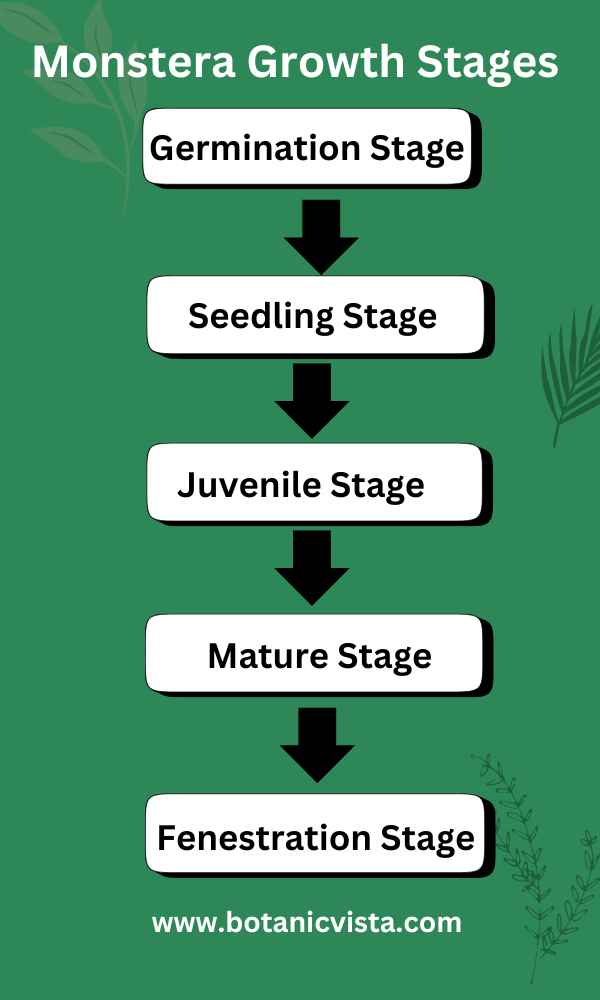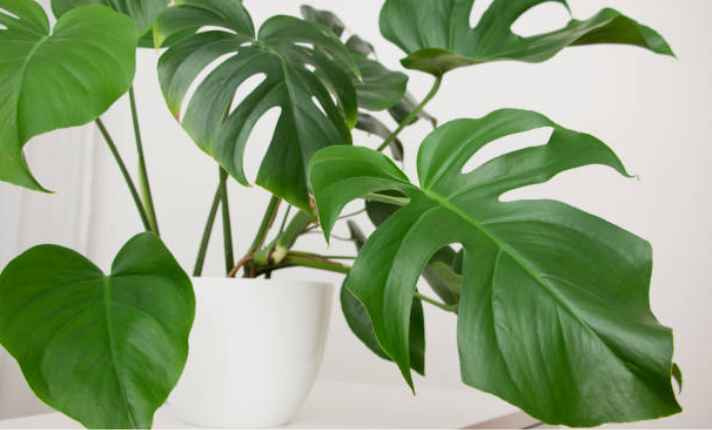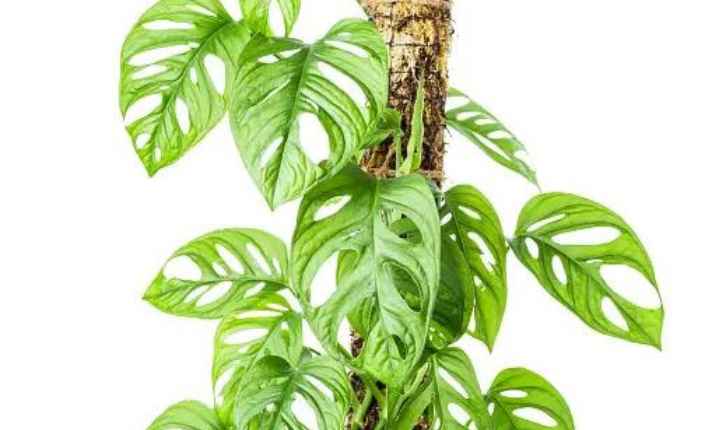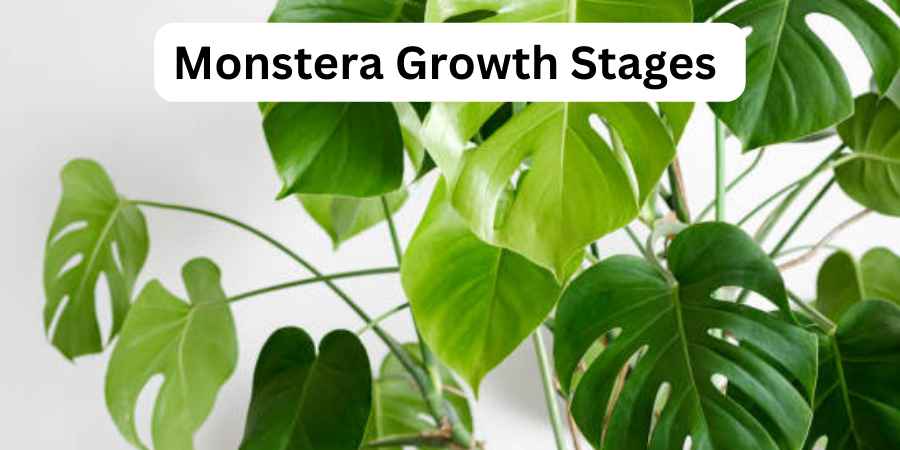Last Updated on June 15, 2025 by Jocelyn
Monstera deliciosa starts as a tiny sprout. This is the germination stage. It needs balanced soil and proper care. Light and moisture help it begin well.
Next, the leaves begin to grow. This is the foliage expansion stage. You will notice small holes forming. These shapes become larger with time. This is called fenestration.
As the plant grows, the stem becomes firm. Roots spread and grip the soil. The Monstera begins to climb. Mature leaves appear. These show healthy progress.
Taking photos or time-lapse videos helps track each stage. You can clearly see how light, water, and space affect growth. Each stage highlights the plant’s change and your role in shaping it.
Table of Contents
Toggle5 Monstera Growth Stages
When you grow a Monstera, it goes through several stages: germination, seedling, juvenile, mature, and fenestration. I remember planting my first seed and eagerly watching it sprout.
Understanding these stages helps in taking better care of Monstera plants. Let’s discuss each stage in detail!

1. Germination Stage
To start planting a Monstera, the germination process begins with obtaining high-quality seeds from a reputable dealer. First, soak these tiny seeds in lukewarm water for 24 hours to aid in sprout emergence.
After soaking, fill a container with well-draining potting mix, ensuring the soil remains moist but not soggy. Place the seeds on the surface and lightly cover them with soil.
Keep the container in a bright spot but avoid direct sunlight. The temperature should be warm to help the seeds sprout in about 7-21 days.
During this process, maintain the soil evenly moist. The Monstera seeds typically show signs of life after two weeks, starting their transformation into leafy plants.
Observing the tiny sprouts is a delightful experience, marking the beginning of their journey to becoming large, beautiful Monsteras.
2. Seedlings Stage
When Monsteras start their journey, they begin as tiny seedlings. These fragile plants depend on the right conditions to grow.
First, the seed makes its debut by emerging from the soil. In this stage, the seedling has small cotyledons, which are the plant’s first leaves.
Over the next several weeks, the seedlings start developing true leaves. This phase is quite adventurous for the young plants as they need special care. They require moist soil and the right temperature.
During this time, roots will start crawling along the ground, and aerial roots, or spaghetti-like tendrils, will appear.
As weeks pass, you might notice nodes and splits in the leaves, a signature of the Monstera species. These extra structures give the plant its unique look. With patience and the right care, these tiny plants will drop their first roots and start growing.
3. Juvenile Stage
I remember seeing a juvenile Monstera with its small, heart-shaped leaves. These young plants have solid green foliage and emerge near the dark soil. They need indirect light to avoid curling leaves. I found that placing them near a window with filtered light is ideal.
In the first few months, the plant’s roots develop, requiring space, so start with a 20 cm pot. Over time, the leaves show slits and irregular shapes. Aerial roots help the plant latch onto surfaces.
Monsteras can grow up to 90 cm tall, adding a unique touch to any landscape. Proper care will ensure your Monstera grows strong and healthy.
4. Mature Stage
When a Monstera reaches the maturity stage, it starts to grow new features that make it look like an adult. At this stage, the plant can grow up to 8 feet in height and produce large leaves with splits and holes.
Aerial roots begin sprouting from the stem, helping the plant grow deeply into the soil. These roots can attach to a trellis or other supports to keep the plant from bending under its own weight.
Without proper support, the stem might bend, causing the plant to lose its shape. In this stage, the Monstera’s growth rate increases, and it needs more space, depending on the species.
A Monstera can reach maturity in just 1.5 years and spread about 3 feet in size. Using a sturdy trellis or moss pole helps maintain its shape and ensures the plant grows healthily.
This stage is crucial for the plant as it steps into its adult world, requiring consistent care to maintain its health and shape.

5. Fenestration Stage
Monstera, also known by the nickname Swiss cheese, develops fenestrations or holes in its leaves over time. Initially, the leaves are solid, but over several months, they start to produce see-through sections. This feature enhances the plant’s unique appearance.
Light and water are crucial for producing fenestrations. Ensuring the plant receives adequate light helps it grow strong and healthy.
A balanced fertilizer supports its growth. As the Monstera gets older and continues to grow, its leaves become entirely fenestrated.

Monstera Care: Tips for Each Growth Phase
Monstera plants are amazing. They go through different stages as they grow. Let’s talk about how to take care of them at each phase.
Germination
Germination is the first stage where Monstera seeds start to sprout and come to life. This phase requires a bit of patience and the right conditions to kickstart the plant’s journey.
- Soil Preparation: Use a well-draining mix to plant the Monstera seeds.
- Moisture: Keep the soil consistently moist but not soggy.
- Warm Environment: Place the pot in a warm, cozy spot.
- Light: Ensure the seeds receive bright, indirect sunlight.
- Time: Germination can take several days to weeks.
Seedling
In the seedling stage, the tiny Monstera plants need extra care to grow strong roots and leaves. This is when they start to show their first real signs of growth.
- Transplanting: Once seeds sprout, transplant them to a slightly larger pot.
- Watering: Keep the soil moist, like a wrung-out sponge, and avoid overwatering.
- Light: Place seedlings in bright, indirect sunlight.
- Feeding: Use a dilute, half-strength Monstera Plant Food to provide essential nutrients.
- Humidity: Maintain high humidity around the seedlings, using a humidifier if necessary.
Juvenile
As the Monstera transitions into its juvenile stage, it starts to grow more rapidly and requires more support and nutrients. This stage is crucial for establishing a strong structure.
- Support: Introduce a moss pole or trellis for the plant to climb.
- Watering Routine: Gradually increase watering frequency as the plant grows.
- Soil Check: Ensure the top inch of soil is dry before watering again.
- Humidity: Keep the environment humid to mimic the plant’s natural habitat.
- Nutrients: Continue feeding with a balanced, half-strength fertilizer.
Mature
The mature stage is when the Monstera becomes a large, impressive plant. It needs regular maintenance to keep it healthy and looking its best.
- Regular Maintenance: Pinch off any dead leaves and shape the plant as desired.
- Fertilizing: Use a half-strength fertilizer regularly, especially if leaves appear pale.
- Humidity: Maintain high humidity with regular misting or a humidifier.
- Light: Ensure the plant gets bright, indirect sunlight.
- Support: Provide a sturdy support system as the plant gets heavier and larger.
Fenestration
Fenestration is the stage where the Monstera develops its signature leaves with holes. This indicates a healthy and well-cared-for plant.
- Leaf Development: Monitor for the appearance of fenestrated leaves (leaves with holes).
- Nutrient Needs: Ensure the plant has enough nutrients to support fenestration.
- Watering: Keep the soil moist but avoid waterlogging.
- Light and Humidity: Maintain optimal light and humidity levels to encourage healthy growth.
- Observation: Regularly check for signs of stress, such as black spots or yellowing leaves, and adjust care routines accordingly.
FAQ’s
Q: How Long Does Monstera Take to Grow?
A: Monstera deliciosa is an easy-to-grow plant. It takes about 1 to 2 years to reach maturity. Its heart-shaped leaves split and become glossy as it grows.
In the first year, it can grow 1 to 2 feet. A full-grown Monstera can reach 2 feet in size. In three years, it can become a climbing plant.
Q: What Is the Growing Pattern of Monstera?
A: Monstera is a tropical plant that grows fast with the right conditions. New leaves appear, and it can add height every year. A mature Monstera can grow tall and start producing big leaves within three years.
Growth can slow if the pot size isn’t changed regularly. Monstera vines may get restricted if the pot is too small, which is a key growth factor for healthy plants.
Q: Do Monsteras Like to Be Root Bound?
A: A root-bound Monstera can struggle because it can’t hold enough moisture. Water zips through the pot, making the plant constantly thirsty like a tourist in the desert.
Providing more space for roots improves moisture retention, ensuring a healthier growth environment and a win for the plant.
Q: Should I Use a Moss Pole for Monstera?
A: Yes, you should use a moss pole for your Monstera. It helps the plant climb and provides essential support, mimicking its epiphytic nature in the wild. My Monstera grew better and stronger with a moss pole.
Q: How to Make Monstera Grow Huge?
A: To make your Monstera grow big, keep the soil moist but not soggy. During the summer, give it extra attention. It needs lots of sunlight and water for growth in this season.
Fertilize every two weeks to help it keep growing. Ensure it has good access to light and water.
Conclusion
Monstera plants need weekly watering and indirect sunlight. I started with small seeds and watched my plant grow large, beautiful leaves. Regular care, like checking soil moisture and using balanced fertilizer monthly, helps ensure your Monstera grows well and stays healthy.
Learn more:

